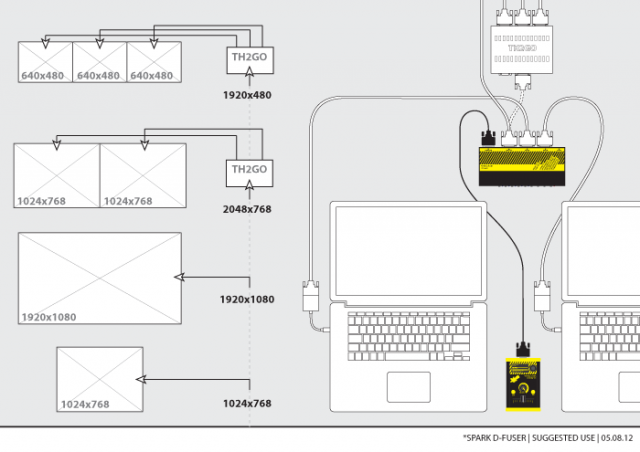*spark d-fuser: demo from toby*spark on Vimeo.
It’s been a long time coming, but it’s nearly here. The first hardware mixing for laptops that’s practical and affordable for the visual community has arrived. And it should be just the tip of the iceberg.
Back in 2009, we celebrated Toby Spark’s community-led video mixing, and bravely (perhaps bravely and prematurely) declared that the era of high-quality hardware mixing was at hand.
It is, of course, a simple premise. You’ve got one laptop, and you want to crossfade to another. And you don’t want to use an analog signal – least of all when coaxing such signals out of modern laptops requires extra hardware.
That is, at last, what you get with Toby’s mixer. Actually getting to shipping hardware took Spark longer than expected, but it’s here now. An ordering period first week of September will mean shipping units are imminent. Also encouraging: while this isn’t open source hardware – owing to off-the-shelf components that make it possible – the new firmware that operates the controller is fully free and open source. That could help build a foundation for other tools to come. Toby tells CDM more about the news of the *SPARK D-FUSER.
CDM: What’s the story?
Spark (here referring us to his video text):
The *spark d-fuser lets you cross-fade between laptops. It’s compact, affordable and — after quite some time(!) — I’m now ready to make the manufacturing run. So this is the final prototype, and with this I’m making this video to demonstrate the features and functionality so you can decide whether you want to have one yourself. If you do, you need to order now so that it can go and be made as part of that manufacture run.
But what’s the actual hardware? What does it do?
It’s a two-source DVI/VGA video mixer that can mix up to full HD and feed into a Matrox TripleHead2Go.
Okay, let’s back up. How did you get here?
In 2009 I was looking at rackmount AV equipment for D-Fuse, expensive and big but the only way I could see to mix between laptops using tripleheads. Asking some questions to TV One’s technical support, they put me onto a product they were just releasing, and my jaw hit the floor: a perfect partner to laptops, at a fraction of the price of its rackmount siblings. While it didn’t have a cross-fader, it did have a published spec to remote control it. Having made a working controller for our use in D-Fuse, I then wanted to get it out to everyone.
Well, all the ideas I had about how easily this could be done were pretty quickly shredded, and despite lots of offers of support and partnering-up, nothing worked out and despite lots of time invested by me and others there was still no product to get out there. At the beginning of this year, I was backed at university by an electronics guru and an entrepreneur prize to take it back on myself, and thats what is now on offer: a complete re-boot of the project, a 100% toby*spark operation.
I’ve financed all the development myself, and am now ready to manufacture. So its less funding the project, and its more putting down your money so yours can get made. You’ll get a TV One video processor that has been set up to partner your controller from the manufacturing run.
Thanks, Toby. So, this is the first generation, the first step toward a future in which we dream of endless laptop mixing and routing and the like on the cheap. But it’s an exciting moment nonetheless. We’ll be following up more with Mr. Spark himself to see how this evolves and what will be practical for visualists.
http://sparklive.net/
http://sparklive.net/purchase-production/
